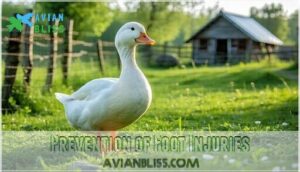This site is supported by our readers. We may earn a commission, at no cost to you, if you purchase through links.

Check their feet for wounds, swelling, or foreign objects stuck between toes. Hard surfaces, sharp objects, and poor housing conditions often trigger these issues.
You’ll want to examine both feet carefully and look for signs like favoring one leg, reluctance to walk, or visible swelling. While minor injuries might heal with basic first aid, persistent limping needs professional attention.
Understanding the specific cause determines whether you’re dealing with a simple fix or something requiring immediate veterinary care.
Table Of Contents
- Key Takeaways
- Limping Duck Causes
- Why is My Duck Limping
- Foot Injuries Explained
- Nutritional Deficiencies Impact
- Veterinary Care Importance
- Frequently Asked Questions (FAQs)
- How to fix a lame duck?
- What to do when a duck is limping?
- Why is my duck having trouble walking?
- Why is my duck hobbling?
- What to do with a duck with an injured leg?
- How can I tell if my ducks limp is serious?
- What home remedies can I try for a limping duck?
- How long should I wait before taking a limping duck to the vet?
- Can a limping duck recover on its own without treatment?
- Are there any long-term effects of a ducks limp?
- Conclusion
Key Takeaways
- Check your duck’s feet immediately – Look for cuts, swelling, foreign objects between toes, or signs of bumblefoot infection that could be causing the limping.
- Don’t ignore nutritional deficiencies – Niacin deficiency is a common cause of duck limping, so ensure you’re providing a balanced diet with proper vitamins and minerals.
- Seek veterinary care if limping persists – If your duck can’t bear weight, shows severe swelling, or doesn’t improve within 24-48 hours, you need professional diagnosis and treatment.
- Prevent future injuries through proper housing – Keep their living area clean, remove sharp objects, maintain dry surfaces, and provide safe fencing to avoid predator attacks and environmental hazards.
Limping Duck Causes
When you notice your duck limping, several underlying causes could be affecting their mobility and overall health.
Understanding these common causes helps you identify the problem quickly and take appropriate action to restore your duck’s comfort and well-being, which is crucial for their overall health.
Common Injury Types
Anybody who keeps ducks knows that injuries happen. Your duck’s limping often stems from leg fractures caused by falls or getting caught in fencing.
Dislocated joints occur when ducks slip on wet surfaces or during rough play. Predator attacks leave wounds that cause duck leg pain and mobility issues.
Bumblefoot causes swelling and limping from bacterial infections entering through small cuts. Common bird injuries such as sprains and strains may also affect a duck’s gait.
Proper wound care prevents minor duck leg injuries from becoming serious duck leg problems requiring veterinary intervention, which is crucial for the well-being of the duck and can help prevent mobility issues.
Potential Infection Sources
Infections often stem from waterborne pathogens in contaminated ponds, where bacteria like E. coli and Staphylococcus enter through small cuts.
Dirty bedding harbors fungal spores that cause persistent duck lameness.
Parasite vectors like leeches attach to webbing, creating wounds susceptible to secondary infections.
Wound contamination from sharp debris introduces bacteria, potentially leading to bumblefoot duck conditions.
Introduced diseases from new flock members can spread infectious duck leg injury problems rapidly, often due to infectious duck leg injury.
Dietary Deficiencies Impact
Poor nutrition can silently sabotage your duck’s mobility.
Poor nutrition can cripple your duck before you notice the damage.
Vitamin deficiency, particularly niacin deficiency duck situations, causes painful lameness that mimics injuries.
Mineral imbalance affects bone strength, while inadequate protein sources weaken muscles supporting joints.
Insufficient calcium intake leads to brittle bones prone to fractures.
Niacin importance can’t be overstated—this B-vitamin deficiency creates classic duck limping symptoms that proper duck care and balanced nutrition easily prevent.
Why is My Duck Limping
Your duck’s limping could signal several underlying issues that need immediate attention. Duck mobility problems range from minor injuries to serious health conditions requiring veterinary care. Understanding the severity helps you respond appropriately and prevent complications.
Here are key factors to evaluate when your duck shows walking difficulty:
- Limp severity assessment – Notice if your duck favors one leg, completely avoids weight-bearing, or shows intermittent weakness
- Duck age considerations – Younger ducklings may have developmental issues while older birds often face arthritis or wear-related problems
- Breed predisposition factors – Heavy breeds like Pekins experience more leg stress than lighter varieties
- Environmental factors impact – Wet, muddy conditions, sharp objects, or uneven surfaces increase injury risk
Watch for additional symptoms like duck leg swollen areas, reluctance to move, or complete inability to bear weight. Duck leg weakness often develops gradually, while sudden onset limping typically indicates trauma or infection. Environmental factors play a vital role in both causing and preventing mobility issues in your flock; similarly, poor ventilation impacts duckling health and can lead to further complications.
Foot Injuries Explained
Foot injuries are among the most common reasons you’ll see your duck limping around the yard.
These injuries can range from minor cuts and scrapes to more serious problems like fractures or infections that need immediate attention.
Symptoms of Foot Injuries
When foot injuries occur, you’ll notice several telltale signs that something’s wrong.
Watch for a swollen foot that looks puffy or enlarged compared to the other.
Redness signs around the affected area indicate inflammation or possible infection.
Your duck may show mobility issues like favoring one leg or refusing to bear weight.
Duck leg swollen conditions often accompany visible lesion appearance – cuts, scrapes, or open wounds.
Behavioral changes include reluctance to move, decreased activity, and obvious duck walking difficulty or duck leg weakness.
Treatment for Foot Injuries
Once you’ve spotted the signs, prompt treatment makes all the difference in your duck’s recovery.
Clean wounds daily with saline solution and apply sterile bandages to prevent contamination. For serious injuries, veterinary care guarantees proper healing.
You can find products for essential duck first-aid online.
- Wound Care – Gentle cleaning with diluted antiseptic removes bacteria while avoiding harsh chemicals that delay healing
- Pain Management – Veterinarian-prescribed medications reduce swelling and improve mobility during recovery periods
- Splint Application – Professional immobilization supports fractured bones and prevents further damage from movement
Prevention of Foot Injuries
Keeping your duck healthy means staying ahead of problems.
Maintain Safe Surfaces by removing sharp objects and debris from their living area.
Keep the Clean Coop dry and well-maintained to prevent bacterial growth that causes duck leg infection.
Install proper Predator Control fencing to prevent attacks leading to duck leg fracture or duck leg sprain.
Schedule Regular Checks of your duck’s feet and legs weekly.
Monitor Proper Weight through balanced nutrition, as obesity increases duck leg dislocation risks and compromises overall duck health.
Nutritional Deficiencies Impact
Your duck’s limping might stem from poor nutrition, which weakens bones and joints over time.
A balanced diet with proper vitamins and minerals keeps your feathered friend walking strong and healthy.
Importance of Balanced Diet
Your duck’s nutritional needs go far beyond basic survival. A well-balanced diet directly impacts nutrient absorption, growth rate, and immune strength. Poor nutrition can cause duck leg paralysis and other serious health issues.
Essential dietary components include:
- Protein sources – Support feather quality and muscle development
- Calcium supplements – Prevent bone weakness and egg production problems
- Niacin-rich foods – Avoid niacin deficiency duck complications
Proper nutrition strengthens your duck’s foundation for ideal duck health and prevents many conditions requiring treating duck limping interventions.
Signs of Nutritional Deficiencies
Recognizing vitamin deficiencies and mineral imbalance early helps prevent serious complications like duck leg paralysis.
You’ll notice growth problems in young ducks, poor feather quality, and reduced egg production in laying hens.
Niacin deficiency duck symptoms include weak legs and difficulty walking.
When your duck can’t walk normally, treating duck limping requires consulting a duck vet for proper diagnosis and nutritional correction.
Feather issues can also be signs of malnutrition, indicating dietary deficiencies.
Dietary Supplements for Ducks
When you’ve spotted deficiency signs, targeted supplements can restore your duck’s health.
Here’s the explanation for key supplements:
- Niacin Supplementation – Essential for leg strength; prevents lameness in growing ducks
- Calcium Intake – Supports bone development; use oyster shell or limestone grit
- Vitamin D Sources – Enhances calcium absorption; vital for skeletal health
- Manganese Benefits – Promotes proper bone formation and joint function
Consult your duck vet for proper selenium dosage and supplement timing.
You can find duck niacin products online.
Veterinary Care Importance
When your duck shows signs of limping, you’ll want to get professional veterinary help quickly to prevent the problem from getting worse.
A vet can run diagnostic tests like X-rays or blood work to figure out exactly what’s causing the limping and recommend the right treatment plan for your feathered friend, which is crucial for the health of your duck, and getting the professional veterinary help is essential in this situation.
Recognizing Signs of Limping
You’ll notice your duck favoring one leg or showing obvious gait abnormalities when limping begins.
Watch for behavioral changes like reluctance to move, staying in one spot longer than usual, or difficulty standing.
Check for visible swelling around joints or feet, and examine feather condition near affected areas.
If your duck can’t walk normally, don’t wait – these symptoms require immediate attention to determine the underlying reason and provide proper explanation for the limping.
It’s also important to rule out staphylococcic arthritis symptoms which can cause similar issues.
Diagnostic Tests for Limping
Determining why your duck limps requires proper diagnosis through veterinary tests.
X-ray Analysis reveals fractures or joint problems, while Blood Tests check for infections and nutritional deficiencies.
Swab Cultures identify bacterial causes like bumblefoot. Gait Observation assesses movement patterns, and Palpation Exam detects swelling or pain.
A thorough examination should include footpad scoring guidelines to assess dermatitis. These tests provide the explanation needed to pinpoint the exact cause and reason behind your duck’s limping symptom, allowing for effective treatment.
Treatment Options for Limping Ducks
Once diagnostic tests reveal the cause, your vet will recommend specific treatments.
The reason behind each treatment depends on your duck’s condition and severity.
Treatment options include:
- Home remedies – Rest, warm compresses, and gentle cleaning for minor issues
- Bandaging techniques – Protective wrapping to support injured feet or legs
- Pain management – Anti-inflammatory medications to reduce discomfort and swelling
- Hydrotherapy benefits – Shallow water therapy to promote healing and mobility
- Alternative therapies – Acupuncture or massage for chronic conditions
Your vet’s explanation will guide the best treatment approach for your limping duck’s recovery.
Frequently Asked Questions (FAQs)
How to fix a lame duck?
Like a wobbly table, your duck needs careful examination.
Check for injuries, swelling, or infections on feet and legs.
Isolate the duck, provide clean water, and consult a veterinarian for proper diagnosis and treatment.
What to do when a duck is limping?
First, check your duck for obvious injuries like cuts, swelling, or stuck objects between its toes.
If you spot something serious, call a vet immediately.
Otherwise, give your feathered friend some rest in a quiet, safe space away from other ducks, and ensure it gets some rest.
Why is my duck having trouble walking?
Walking woes worry waterfowl owners worldwide.
Your duck’s difficulty walking could stem from bumblefoot infections, leg injuries, nutritional deficiencies, or neurological issues.
Check for swelling, cuts, or unusual positioning that might indicate the underlying problem.
Why is my duck hobbling?
Your duck’s hobbling could stem from several causes: foot injuries, bumblefoot infection, leg sprains, arthritis, or nutritional deficiencies.
Check for swelling, cuts, or heat in the affected area, and consider consulting a veterinarian for proper diagnosis and treatment.
What to do with a duck with an injured leg?
Carefully care for your injured duck by confining it to a quiet, comfortable space with clean bedding.
Check for visible wounds, swelling, or heat. Provide easy access to food and water.
Contact an avian veterinarian promptly for proper diagnosis and treatment.
How can I tell if my ducks limp is serious?
Watch for severe swelling, inability to bear weight, dragging the leg, or visible deformity.
If your duck can’t walk normally or the limping worsens after 24-48 hours, it’s serious and needs veterinary attention promptly.
What home remedies can I try for a limping duck?
Sometimes life throws you a curveball, and your feathered friend needs gentle care.
Rest the duck in a quiet area, check for visible injuries, and provide fresh water access.
Avoid handling unless necessary—time often heals minor strains naturally.
How long should I wait before taking a limping duck to the vet?
You should take your limping duck to a vet within 24-48 hours if there’s no improvement.
Especially if you notice swelling, heat, or the duck won’t bear weight on the affected leg at all.
Can a limping duck recover on its own without treatment?
Like a broken wing keeping a bird grounded, ducks can recover from minor limps naturally.
However, you shouldn’t wait and see – most limping requires veterinary attention to prevent permanent damage or infection.
Are there any long-term effects of a ducks limp?
Long-term limping can cause joint stiffness, muscle weakness, and compensatory injuries in your duck’s other leg.
Untreated issues may worsen, potentially leading to permanent mobility problems or arthritis that’ll affect their quality of life.
Conclusion
Discovering why your duck is limping starts with careful observation of their behavior and physical condition.
You’ll need to examine their feet, legs, and overall posture to identify the root cause. Most limping issues stem from injuries, infections, or nutritional gaps that you can address with proper care.
Don’t delay seeking veterinary help if the limping persists or worsens. Quick action prevents minor problems from becoming serious health concerns that could affect your duck’s long-term mobility and wellbeing.
- https://www.hobbyfarms.com/duck-leg-injuries-causes-treatments/
- https://www.reddit.com/r/duck/comments/1eo6g43/is_there_something_wrong_with_my_ducks_leg/
- https://www.omlet.us/guide/ducks/duck_health/feeling_blue/
- https://dictionary.cambridge.org/us/dictionary/english/amirite?topic=question-words-and-expressions
- https://blog.collinsdictionary.com/cefr-labels-explained/










